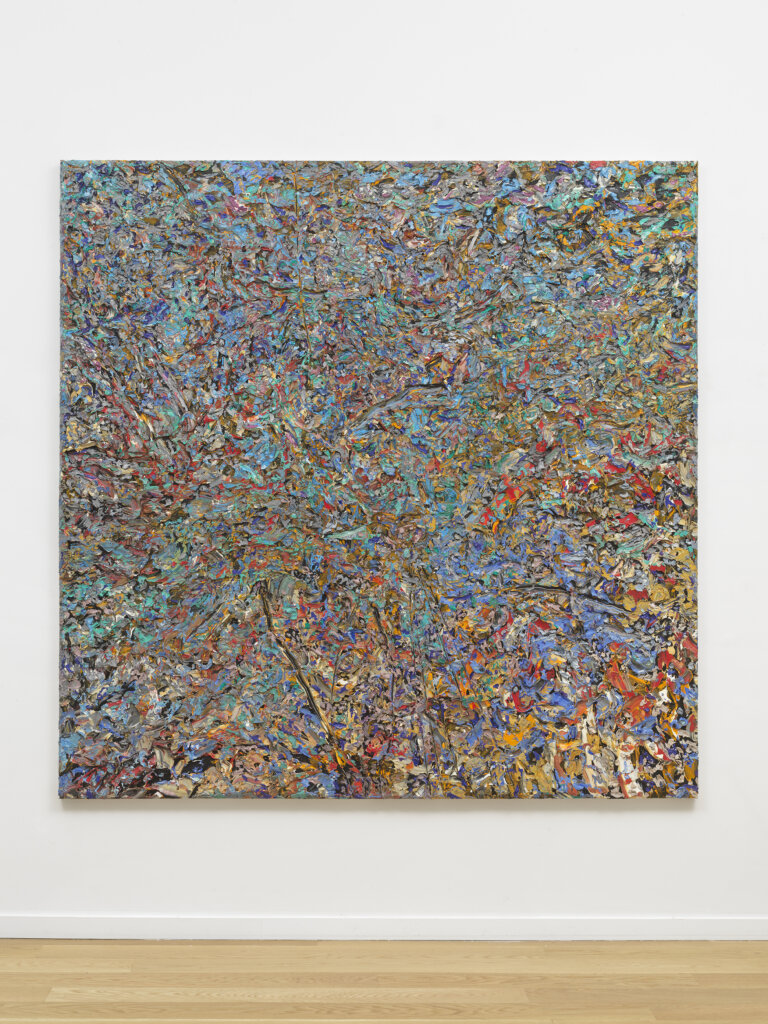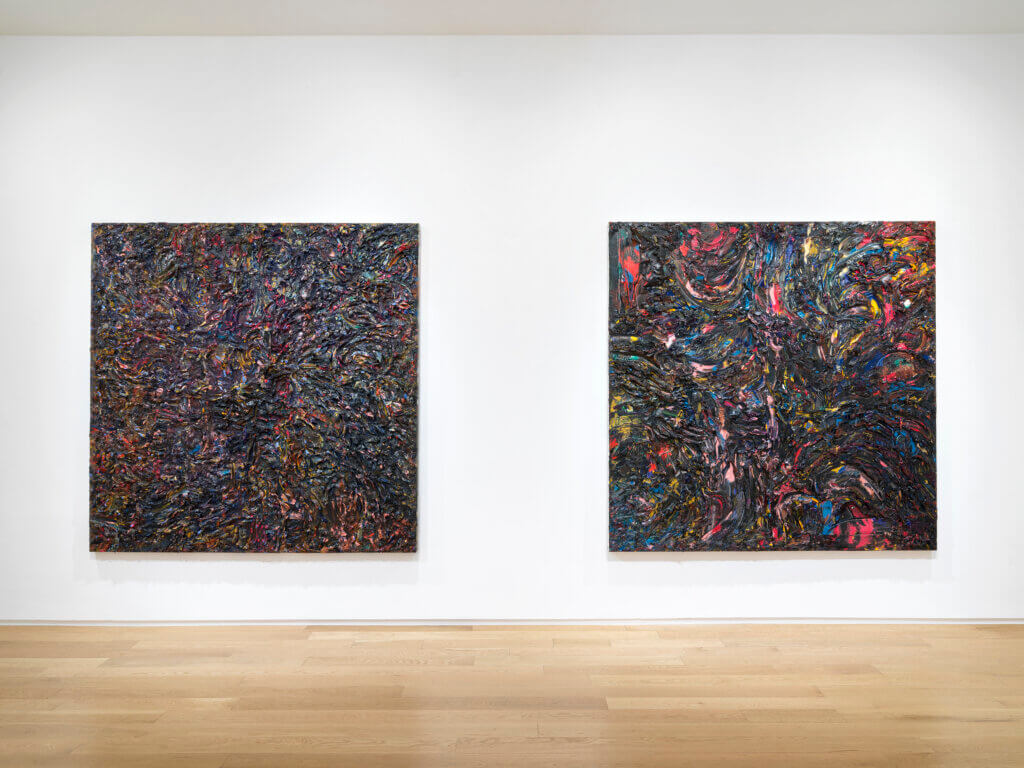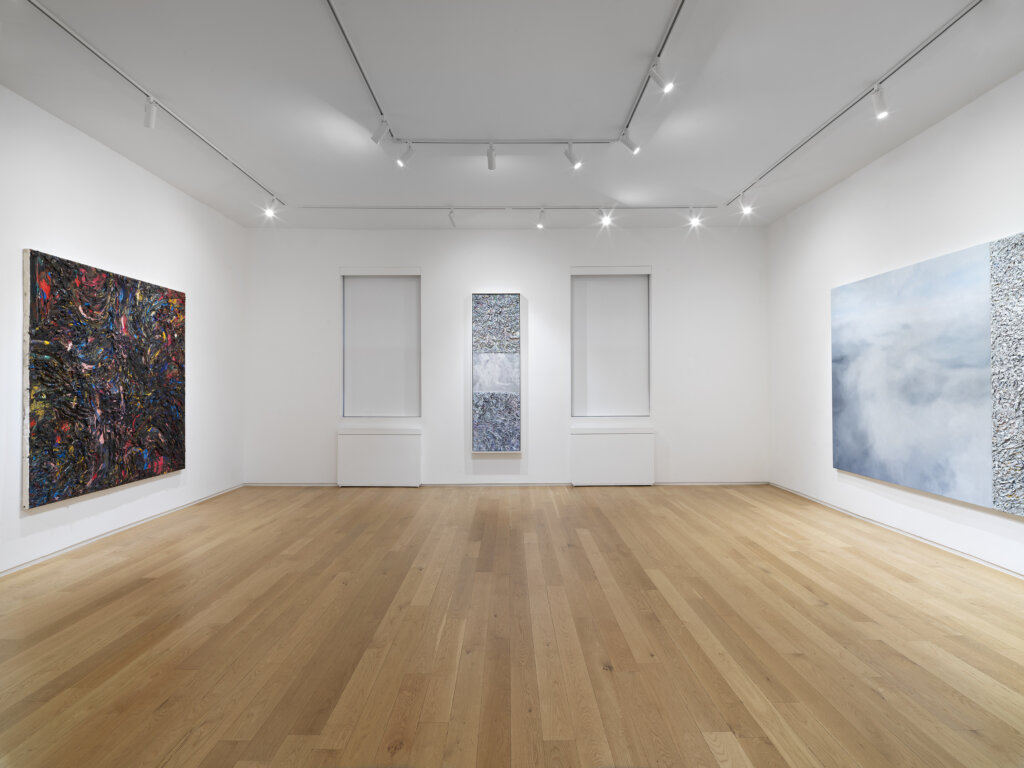By Paul D’Agostino
October 2022

Installation view of Gabriel Mills: Butterfly March (October 19-November 19, 2022) at Alexander Berggruen, NY.
Gabriel Mills has harnessed a deep toolkit of concepts and skills in the creation of his recent paintings gathered in Butterfly March. For the artist, these works are vessels of reverence for, and devotion to, a number of thematic concerns that converge at the crux of his painterly practice, namely time, humility, allegory, transformation, transcendence, rebirth, and spirituality. These paintings are also the compositional spaces where Mills operates with, and seeks to evince, multifaceted modes of focus and autonomy.
Mills is well known for the formal intrigue, chromatic richness, stylistic nuance, and overall illustrational allure he brings to portraiture and representational painting. Verisimilitude and striking likenesses, at times softened by brushy overpainting or misted veneers, or rendered less apparent through darkened atmospherics or limited palettes, are not uncommon in the artist’s works. Mining his way into such visual mystique within figurative registers, and with substantial toil and meticulousness, has long allowed Mills to spend intimate, contemplative time with his subjects – people and objects alike – until they begin to channel the range of emotive significance they have for him. Making things look merely ‘right’ or ‘good’ is not his point. His aim, rather, is to reflect and vivify them until they exude palpable presence and mood.

Gabriel Mills
WEDDING TUX, 2022
oil on canvas
73 x 73 in. (185.4 x 185.4 cm.)
This is now just one of Mills’s manners of conveying notions of reverence, metamorphosis, and transcendence in his works. To wit, his titular reference to butterflies is not incidental. These beloved organisms appear compositionally and – by way of abstraction, formal suggestiveness, and implicit themes – at tangents, but their subtler overall presence in the works is metaphorical. As true agents and symbols of transformation and rebirth, butterflies embody notions of struggle, endurance, hope, promise, and escape if not ecstatic conversion, and their processes of self-actualization that culminate in astonishing aesthetic shifts can be likened to moments of individualized revelations or autonomous expression. Mills finds inspiration in all such thoughts, imbuing his new works with analogous elements of pattern, potential, change, and renewal. For him, the full arc of instantiating, composing, and completing a painting is tantamount to an act of self-realization.
With such thematics in mind, Mills began catalyzing modes of aesthetic metamorphosis within and across his compositions, refocusing his vision so as to introduce a different level of complication to his processes as well as his picture planes. His most notable transitions along such lines entail explorations of various levels of abstraction, from lesser-naturalistic graphic clarities and stylized palettes to ostensibly comprehensive non-objectivity. In rather uniformly treated, lone-picture-plane works such as FUNERAL MARCH and WEDDING TUX, Mills evokes and communes with his subjects by very gradually painting away from candidly representing them – that is, by commencing with loosely representational sketches and contours, then engaging in very slow processes of building up surfaces, thickening them with impasto, and enriching their textures with deep, rather unbrushy brushstrokes, curved and short, laying in robust colors one next to another, mixing by way of wet-into-wet or on brushes rather than pre-application, substantially obscuring underlying forms along the way. As such, Mills allows his subjects to virtually disappear, remaining legible perhaps by chromatic association for viewers aware of titles or themes. Thusly do the darker palette and subtly swirling, thronging lateral movement of FUNERAL MARCH come into coherence, as do the felicitous, somewhat blanched pastels and placid textures of WEDDING TUX. Mills offers a similarly mesmerizing, more metaphorically indirect visual encounter with All the Dancers Twirling in the Rain, Whisper Gently That I’m Out of Place, But Today I’m Reborn. Here, he uses a wider brush, broader marks, and a darkish palette punched through with vivid primaries created both additively and subtractively, by building up and excavating alike, enriching the facture of the surface while enhancing the deft subtlety of its slowly twirling, centrifugal dynamism, all in service to a looser treatment in which forms gradually cohere for viewers through prolonged looking and intuitive interpretation.

Installation view of Gabriel Mills: Butterfly March (October 19-November 19, 2022) at Alexander Berggruen, NY.
Such examinations of abstract color fields and embedded imagery show Mills morphing his way away from himself, as it were, to locate new pathways of representation that demand no less time, meticulousness, and intimacy, and that consistently beg acutely mindful scrutiny from his audience. In many of the other works in Butterfly March, the artist takes this much further, complicating his processes and picture planes by working in curiously proportioned, asymmetrical triptychs presented as long horizontals or verticals. Such works nod discretely to the religious history of trinities and altarpieces while also unfurling, given their stretch, as scrolls, thereby commanding immediately a heightened level of presentness and visual engagement from viewers. These multiple-panel paintings tend to involve two or three different registers of chromatic or representational abstraction. Works such as Glassinela, VELOACRA, and The Lily of the Field and the Bird of the Air feature couplets of similarly brushworked, viscously textured panels. The latter opens its sequence, however, with one panel of softly, wispily rendered cloudscape, while the other two, both imposing verticals, fold lesser-brushily treated panels suggestive of ice or marble, earth or magmatic, molting stone into the crux of their set. In such pieces, modes of metamorphism and transition occur slightly, yet unmistakably from one panel to the next. In other triptychs, this protean aspect is more pronounced in terms of chromatics and pictorial resolve. In Savonarola, for instance, the martyr’s fate is implicitly evoked by way of three panels of readily differentiable palette and abstraction that become, from left to right, progressively tight, and that link together formally, in part, by way of a diffuse, dramatically interspersed ooze of rich, deeply variant rouge. Aeternam, meanwhile, charts a course from left to right with a blazing, naturally rendered sunset; a narrow strip of tightly abstracted, crystalline pastels; and a more openly brushy, substantially textured panel that reads, with remove, as a topographical landscape.
In the triptych Baptized in the Garden by the Breath of Pain, and in the single-surface piece TUTU, Mills discovers new focus, intimacy, autonomy, and notes of transcendence well within or near his customary modes of naturalistic representation. In the triptych, the artist offers a fully figurative vision of dancers at rehearsal, a significantly realistic rendering of a pile of Air Jordan sneakers, and a graphically stylized silhouette-scape of a crepuscular creek, glowingly illumined by an apparitional duo, twinkling and fluttering, of a hummingbird and a butterfly. This perhaps lightly autobiographical sequence reads, from left to right, like a dreamily azure, mysteriously illustrated allegory of flight. TUTU, meanwhile, is a composition of multiple, somewhat sectioned-off treatments – six clearly distinct ones, in full – featuring an asymmetrically centered portrait flanked all around by five swatches of variably punchy, boldly graphic forms and whispery abstractions. This intimate, arresting work is, in a sense, the most pictorially multifaceted, internally transformative, candidly complex painting in Butterfly March. It shows Mills summoning his full toolkit and challenging himself on all registers of exploration and skill, firing on all graphic and conceptual cylinders, and delivering a sui generis composition that can be read as a particularly inspired painterly index for all the others in the exhibit.

Gabriel Mills
TUTU, 2022
oil on wood panel, framed
24 x 24 in. (61 x 61 cm.)
Gabriel Mills brings his full creative self to Butterfly March. He reveals a variably broadened, freshly individualized painterly approach that expands his vocabulary of representation and abstraction, and that merges clarity and ambiguity into uniquely envisioned, profoundly evocative registers of pictorial lexicality. In this, Mills discloses much, offering his own manners of artistic metamorphosis as analogues for the metamorphoses and intimacies he seeks to convey in his works. Newly grounded, aesthetically, and metaphorically ascendant, he marches alongside his metaphorical butterflies as they flutter on into greater transcendence.
– Paul D’Agostino, PhD is an artist, writer, curator, and translator.
This essay will appear in a forthcoming catalogue published on the occasion of Gabriel Mills: Butterfly March alongside an interview of the artist by Danni Shen and a poem by Rebecca Mills.

Installation view of Gabriel Mills: Butterfly March (October 19-November 19, 2022) at Alexander Berggruen, NY.
Photos: Dario Lasagni